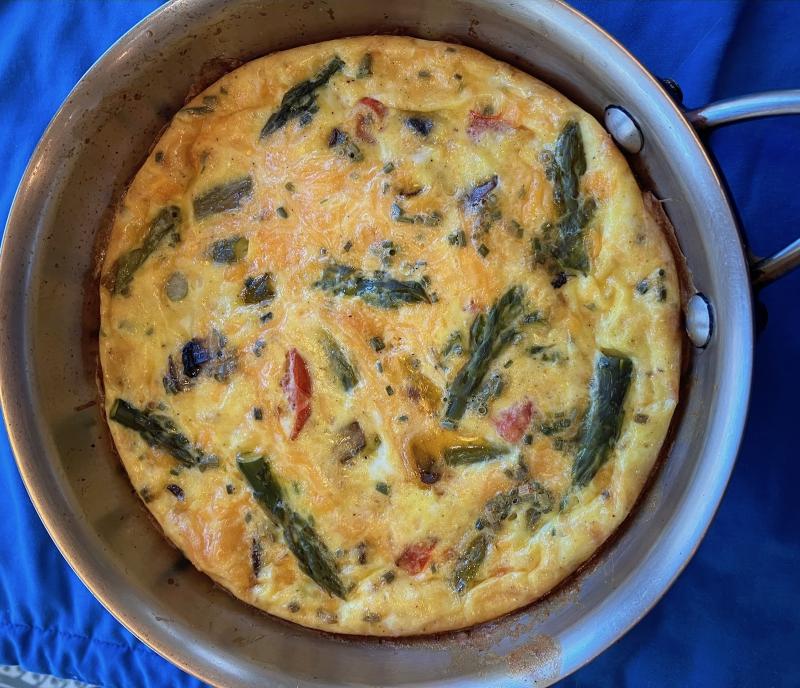Spring is the time for fresh asparagus adventures
Forsythia, daffodils, cherry blossoms and asparagus are some of the colorful highlights of spring. As for the last item, you’ll see plenty of bright-green spears arrayed in your favorite grocery store. Although you can usually find them year-round, thanks to growers in Mexico and South America, the tastiest of these are from local farmers.
Asparagus is an excellent example of why fresh-picked produce is superior to foods that travel long distances before reaching the consumer. The spears grow upward from an underground crown after waiting at least two years for the root system to become established. In the third year and for as long as 20 years, you may harvest the spears, which can grow was much as seven inches in a day.
When you cut them at the base of the stalk, they immediately begin to lignify, or deposit fibrous cellulose compounds in their cell walls, creating an undesirable tough texture. One way to see this is to examine the bottom of the stalks at the market, typically set in a basin with an inch of water. Instead of appearing moist and green at the base, the cut edge will look whitish and woody.
When preparing asparagus for cooking, the common advice is to hold the spears at their midpoint in one hand and the bottom in the other hand, then bend the stalk until it snaps and breaks. Unfortunately, there is no guarantee that this is the best spot to separate the tender top from the fibrous lower stalk. A better alternative is to cut rounds from the base of one stalk until you see where the white transitions to green, then use that as a guide for the rest of the bunch.
Another piece of advice that may not work is trimming the outer flesh from the base of the stalk with a vegetable parer. This does nothing to remove any toughness from the stalk’s interior. Thicker stalks don’t always mean the asparagus is fresher, as you can find them pencil thin or quite thick. Just be sure to avoid any that are spindly, dry, and pitted.
Asparagus is depicted on a carved Egyptian frieze dating to 3000 BC, and food historians believe it was also known in Syria and Spain. Ancient Greeks enjoyed asparagus, and the Romans appear to have been the first to cultivate the vegetable more than 2,000 years ago. The English name derives from Latin, and it was once known as sperage. You can find white asparagus more readily in Europe, while the green variety is a richer nutritional source of vitamins and trace minerals.
When choosing asparagus for your next recipe, base your decision on how it will be prepared. The skinny ones are great for dishes that require little or no cooking, such as a stir-fry or a salad. Reserve the thicker spears for steaming or roasting. If they become overcooked and mushy, throw them into a soup or chop them to flavor a frittata, as in the photo. Unlike omelets, frittatas are finished in the oven and unlike quiche, they don’t have a crust.
For two final bits of vegetable lore regarding asparagus, it has long been considered an aphrodisiac, and eating it will make your urine smell odd. The first of these has a basis in the positive effects of vitamin E on your metabolism, and the second depends upon whether or not you have a specific genetic variation that allows you to smell the odor. Enjoy this delicious taste of spring!
Asparagus Frittata
4 eggs
2 T heavy cream
1/2 t salt
1/4 t white pepper
2 T butter
6 to 8 stalks asparagus, chopped
1/2 C sliced mushrooms
2 T chopped sun-dried tomatoes
1 C shredded cheddar cheese
Preheat oven to 350 F. Whisk together eggs, cream, salt and pepper; set aside. Melt butter in a small skillet over medium heat. Add vegetables and cook until they’re tender and all moisture has evaporated. Pour in egg mixture and cook until eggs just begin to set. Sprinkle with cheese and place in the oven. Cook until lightly browned and puffed, about 20 minutes. Serve immediately. Yield: 3 to 4 servings.
Steamed Asparagus
1 lb fresh asparagus
salt, to taste
1/2 C water
Trim the woody ends from the asparagus spears. Place upright in an asparagus steamer or lay flat in a skillet. Sprinkle with salt and add water. Cover and steam until tender, about 2 or 3 minutes. Drain and serve with hollandaise sauce or lemon vinaigrette.
Lemon Vinaigrette
juice of 1 lemon
1 T olive oil
1 t rice wine vinegar
1 minced shallot
1/4 t dry mustard
salt & pepper, to taste
Whisk the ingredients together until well combined. Drizzle over steamed asparagus.
Asparagus Soup
1 T butter
1 chopped onion
1 chopped shallot
1 lb asparagus
1 1/2 C baby spinach
4 C chicken stock
1 t tarragon
1/8 t grated nutmeg
salt & pepper, to taste
Melt the butter in a large saucepan. Add the onion and shallot; cook until wilted. Trim and chop the asparagus, discarding any woody stems, reserving s few tops for garnish. Shred the spinach, discarding any stringy stems. Add both to the pan and cook briefly, stirring often. Pour in the stock and bring to a boil. Reduce heat, cover and simmer until vegetables are mushy, about 15 minutes. Using a food processor or immersion blender, puree until smooth. Stir in tarragon and nutmeg; adjust seasonings with salt and pepper, garnish with reserved tips to serve. Yield: 6 servings.























































